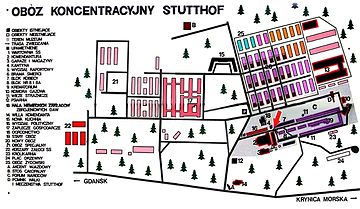KZ Stutthof
| Stutthof concentration camp | |
|---|---|

Map of KL Stutthof main camp after expansion. The German armaments factory DAW (Deutsche-Ausrüstungs-Werke) to the right (black, outlined in red) by the prisoner barracks. Death gate marked with an arrow, next to the red-brick SS administration building (photo below). The Stutthof Museum permanent exhibit
|
|

KL Stutthof Museum panorama, 2007
|
|
| Operation | |
| Period | 2 September 1939 – 9 May 1945 |
| Prisoners | 110,000 (with 85,000 dead) |
Stutthof was a Nazi German concentration camp built in a secluded, wet, and wooded area near the small town of Sztutowo (German: Stutthof) 34 km (21 mi) east of the city of Gdańsk in the former territory of the Free City of Danzig. The camp was set up around already existing structures after the invasion of Poland in World War II, used for the imprisonment of Polish intelligentsia. The actual barracks were built in the following year by hundreds of prisoners enslaved in specialized commandos. Stutthof was the first camp outside German borders, in operation from 2 September 1939, and the last camp liberated by the Allies on 9 May 1945. More than 85,000 victims died in the camp out of as many as 110,000 inmates deported there.
As early as 1936 the Nazi authorities of the Free City of Danzig began compiling target data about known Jewish and Polish intelligentsia, and were secretly reviewing suitable places to set up concentration camps in their area.
Originally, Stutthof was a civilian internment camp under the Danzig police chief, before its subsequent massive expansion. In November 1941, it became a "labor education" camp, administered by the German Security Police. Finally, in January 1942, Stutthof became a regular concentration camp.
The original camp (known as the old camp) was surrounded by the barbed-wire fence. It comprised eight barracks for the inmates and a "Kommandantur" for the SS guards, totaling 120,000 m². In 1943, the camp was enlarged and a new camp was constructed alongside the earlier one. It was also surrounded by electrified barbed-wire fence and contained thirty new barracks, raising the total area to 1.2 km² (0.5 sq mi). A crematorium and gas chamber were added in 1943, just in time to start mass executions when Stutthof was included in the "Final Solution" in June 1944. Mobile gas wagons were also used to complement the maximum capacity of the gas chamber (150 people per execution) when needed.
...
Wikipedia
